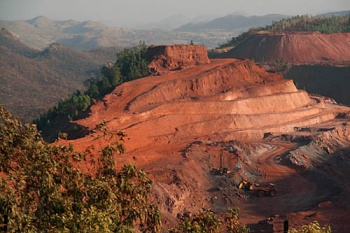Difference between revisions of "Mining and Metals"
(aluminium category) |
m (links) |
||
| Line 36: | Line 36: | ||
|style="color:#000;"| | |style="color:#000;"| | ||
| − | Aluminium is more energy intensive and polluting than any other metal to produce. The industry goes to great lengths to portray this shiny and versatile metal as part of the solution to climate change due to its recyclability and lightweight nature. But the real story of aluminium is one of destruction, displacement and waste. | + | Aluminium is more energy intensive and polluting than any other metal to produce. The [http://www.powerbase.info/index.php/Category:Aluminium_Industry industry] goes to great lengths to portray this shiny and versatile metal as part of the solution to climate change due to its recyclability and lightweight nature. But the real story of aluminium is one of destruction, displacement and waste. |
====The process and its impacts==== | ====The process and its impacts==== | ||
| − | • Bauxite (aluminium's ore) is shallow strip mined from semi tropical forests, often displacing indigenous peoples and destroying their livelihoods, as well as creating large scale soil erosion and water pollution. | + | • [[Bauxite]] (aluminium's ore) is shallow strip mined from semi tropical forests, often displacing indigenous peoples and destroying their livelihoods, as well as creating large scale soil erosion and water pollution. |
| − | • Bauxite is refined to produce alumina, leaving tonnes of 'red mud' - the caustic and toxic sludge that flooded several Hungarian towns in 2010. | + | • Bauxite is refined to produce [[alumina]], leaving tonnes of 'red mud' - the caustic and toxic sludge that flooded several Hungarian towns in 2010. |
• Alumina is then smelted to remove the strongly bonded oxygen and produce aluminium. This process is often carried out thousands of miles from where it was mined and requires huge amounts of energy, producing highly polluting fluorides, sulphur dioxide, perfluorocarbons (very strong greenhouse gases), cyanide and a classified hazardous waste called [[Spent Pot Lining]]. | • Alumina is then smelted to remove the strongly bonded oxygen and produce aluminium. This process is often carried out thousands of miles from where it was mined and requires huge amounts of energy, producing highly polluting fluorides, sulphur dioxide, perfluorocarbons (very strong greenhouse gases), cyanide and a classified hazardous waste called [[Spent Pot Lining]]. | ||
Revision as of 13:46, 19 July 2011
Welcome to the Mining and Metals portal on Powerbase | ||
|---|---|---|
Why mining and metals?Metals are all around us – from your can of lemonade, to your bike, car or plane, to your laptop, buildings and pots and pans. But we rarely think about where these materials come from and what impact they have on the planet and people. Mining and metals companies, with the support of their trade associations, think tanks, corporate social responsibility programmes and PR agencies, try to paint their products as clean and green. Yet these are among the most polluting and energy intensive industrial processes in the world, often linked to the displacement of indigenous peoples, poor working conditions, conflict, human rights abuses, pollution, climate change and militarisation. Around 30 per cent of aluminium, for example, is used by the arms or 'defence' industry, making it an important 'strategic metal' for most governments. [1] |
|
|
| ||||||||
References
|

